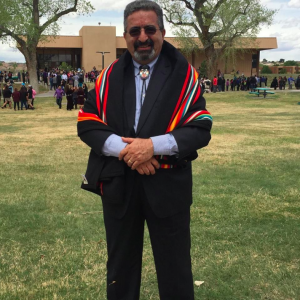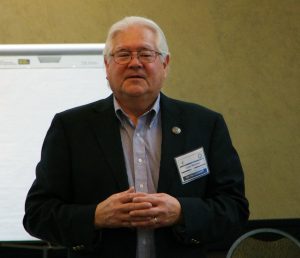by Katie Scarlett Brandt
Engineering Professor Nader Vadiee spends his days trying to fix a leaky pipeline. However, this pipeline isn’t leaking water or oil. It’s losing students.
“Imagine a very leaky pipeline from the community to academia, then to industry and back to the community,” said Vadiee, who heads the Engineering Department at Southwestern Indian Polytechnic Institute in New Mexico. “My students are single moms or dads, the average age 28 or 29. My mission is to get these professionals back to the community to create jobs.”
Building this pipeline requires funding, a significant portion of which comes from federal sources. For this reason, the election of Donald Trump has many in the tribal college community on edge. That’s because, so far, President Trump’s top priorities include:
- The military—increasing defense spending by $54 billion
- Non-renewable energy—issuing an executive order to build the Keystone and Dakota Access pipelines
- Big business—cutting the corporate tax rate from 35% to 15%
What’s less clear: where research and STEM education fit into these goals.
“With the Trump administration and all the scary things we’re looking at with the budget, it’s hard to predict how things are going to pan out,” said Al Kuslikis, senior associate for Strategic Initiatives at the American Indian Higher Education Consortium (AIHEC) in Washington DC. “We’re optimistic because of the history of support from both parties, but we understand that there have to be accommodations made in the priorities of this new administration.”
Dr. Carty Monette, former president of Turtle Mountain Community College in North Dakota, echoes that sentiment. “Any time there’s a shift in federal monies or funding policy, there’s always a risk that things are going to happen.”
Monette led Turtle Mountain College for more than 30 years, and in retirement continues to be involved in advocacy. “I spent most of my adult life at tribal colleges. They present the best opportunity for tribes and tribal members to improve the community.”
The Situation
The 37 tribal colleges and universities across the United States rely on federal money for survival—especially for science, technology, engineering, and math (STEM) programs. Already tribal colleges are at a disadvantage financially compared to mainstream institutions and even other minority-serving institutions, such as historically black colleges and universities.
The legislative authorization for tribal colleges’ operational budgets is $8,000 per student, but in actuality, the colleges receive between $5,000 and $6,000 per student. Meanwhile, Howard University, a historically black school, receives $22,000 per student—significantly higher than tribal colleges, but still lower than mainstream institutions.
But that lack in funding may actually be a plus in this situation, Monette proposed, “because tribal colleges aren’t a big part of federal funding.” They may be able to slip by untouched.
Federal funds comprise between 90 and 95 percent of total funding, according to Monette. Funding for reservation-based tribal colleges comes either from direct aid authorized by a federal act to fund operations or program grants from federal agencies, such as NASA and the National Science Foundation.
What Monette predicts will happen is that federal agencies funding tribal colleges will be rounded up and analyzed for duplication of effort or what government officials “define as wasteful.” From there, officials will begin consolidating and eliminating funds.
“In some cases, they may be able to do that without harming any results, but in the case of tribal colleges, you really can’t afford to lose any of those supplemental opportunities,” Monette said. “If not for the National Science Foundation’s investment in tribal college programs, many wouldn’t even be able to offer the basic requirements for two-year degrees in STEM.”
Turtle Mountain Community College began hunting for money to build its capacity in math and science 20 years ago because “we knew that the jobs of the future were going to require people who knew those disciplines,” Monette said.
As a result of that push for math and science programs, many of the tribe’s own professionals now work within the community—in health, technology, computer programming, and information systems.
“With operational monies being far below what mainstream institutions get,” Monette said, “there’s no way we can keep pace without those supplemental programs. That’s why it’s very important that tribal colleges keep ahead of the game, being able to offer high quality STEM programs.”
Science Under Pressure
President Trump’s bold statements dismissing science—and naming an oil executive as Secretary of State—also contribute to a general feeling of unease among STEM faculty and students at tribal colleges.
Kuslikis said, “Certainly the whole issue of climate change and the lack of support—cutting back on the Environmental Protection Agency and environmental stewardship generally—those are things that are important to tribes and tribal colleges.”
Under Obama, the environment was a top priority. Funding for research and climate science education flourished. The EPA used tribal college eco-ambassadors to help collect data and analyze developing environmental issues, which Kuslikis called “a great, ongoing program, but I’m sure it’s on the chopping block now.”
Other agencies, including the United States Department of Agriculture and the United States Geological Survey, also partner with tribal colleges on climate change. Students and faculty work with regional climate centers, supporting local communities through vulnerability assessments.
Faculty and students monitor a variety of changes in plants and animals—from life cycle transitions to animal migrations to early blooming. They also consult with elders familiar with medicinal plants to identify changes over a longer period of time.
“If all of the sudden that’s not a priority, our efforts have to adapt,” Kuslikis said. “Students and faculty have expressed that this work has to happen regardless of administration priority changes. If you can’t rely on support from the federal government, that doesn’t mean you don’t do the work. You just find other ways.”
Not all bad
Meanwhile, Kuslikis anticipated enthusiasm from the Trump administration in other areas. Advanced manufacturing and computer-aided design may get a boost in funding from various agencies in line with President Trump’s priorities. And through the development of those programs, tribal colleges can find other ways to give back to their communities.
“Tribes can design (materials) customized for their own needs,” Kuslikis said, mentioning a college in North Dakota that uses 3D printing to manufacture arm guards and arrow stands for the local archery team. “They’re filling this community need, and that’s the vision: having a facility where you can design and meet local demand.”
The environment benefits, too. Developing products locally results in the use of less resources and less waste from storage, shipping, packaging, and more in the long run.
Another environmental bonus: Tribes could more readily adapt to changing agricultural productivity as the result of “the c-word—climate change,” Kuslikis predicted. “You’re able to create your own monitoring, your own mitigation tools to restore stream beds or stabilize a habitat. You’re able to identify the problem with your own tools and develop solutions rather than wait for a regional research and development resource to do it for you. It’s an empowering and liberating idea.”
That’s exactly what Vadiee has been doing in his 12 years at Southwestern Indian Polytechnic Institute, as he finds ways to support students and keep them engaged.
“I always keep my sight on this as a two-year school, but I give my students the foundation to move on to a four-year school,” Vadiee said. “I’m finding areas they can come back to the community to help: renewable energy, software development, natural resources management. That’s the real essence of community college—the communities see the real benefit in working with you.”
Building Beyond an Election Cycle
As he prepares current students for four-year schools, Vadiee also inspires future students. It’s all part of plugging those leaky pipes.
Through partnerships with NASA and Native-serving high schools in New Mexico, he developed a four-phase Mars Rover robotics program. Each participating high school receives a 3D printer and a kit to build a Mars Rover, modeled after the automated motor vehicles that NASA sends to Mars to collect environmental data.
Throughout the program, Vadiee constantly stresses, “What is the physics, chemistry, and biology behind this? What is the coding?” By the end, the high school students have done what NASA scientists are actively doing on Mars, and Vadiee’s college students also gain value—internalizing what they’ve already learned by teaching it and inspiring potential students.
The Rover program may continue uninterrupted because it relates to advanced manufacturing, but it also stands to benefit the environment.
“These drones are intended to be used for environmental monitoring,” Kuslikis explained. “They can look at the speed of vegetation, health of soil, scarcity of water. There’s a ton of data you can collect and analyze through remote sensing.”
However, Vadiee’s plans for the Rovers don’t end there. He wants to program them to respond to commands in Native languages, such as Diné. “That creates a lot of excitement because the new generation doesn’t know their native language, but when they use it to talk to the Rover, it’s more exciting.”
Monette added, “With each new administration going back to President Carter, we had to do a re-education of their staff people—what a tribal college is, what they do, the funding situation, characteristics of our students, of our tribes. This is an ongoing process, but we’re at a critical junction now.”
If Monette were still leading Turtle Mountain Community College, he said he would be actively educating his congress people and their staffs, to give them “good ammunition, good rationale to argue continued support for tribal colleges.”
Foundations could also become a stronger player. They need to step up, just as tribal colleges need to get creative on the part of their communities to ensure the communities benefit, Kuslikis said, adding, “I’m totally optimistic, even in the face of what we’re facing. Generally, there’s always been slow and steady progress.”
Though Vadiee admited to worrying about funding under the new administration, he’s accustomed to handling complex problems without easy solutions—a major part of working in science and in academia.
And he has seen progress firsthand: Within 10 years of starting the one-instructor engineering program at SIPI, Vadiee grew it from five students to 75.
“Imagine how you’re supposed to teach five courses and write up these proposals for more funding. It takes a crazy person like me,” he said. “Things like this you cannot build over night. It goes way beyond the four years of the election.” He’s slowly and steadily building a pipeline that’s blocking leaks.
Katie Scarlett Brandt is a freelance writer based in Chicago.


